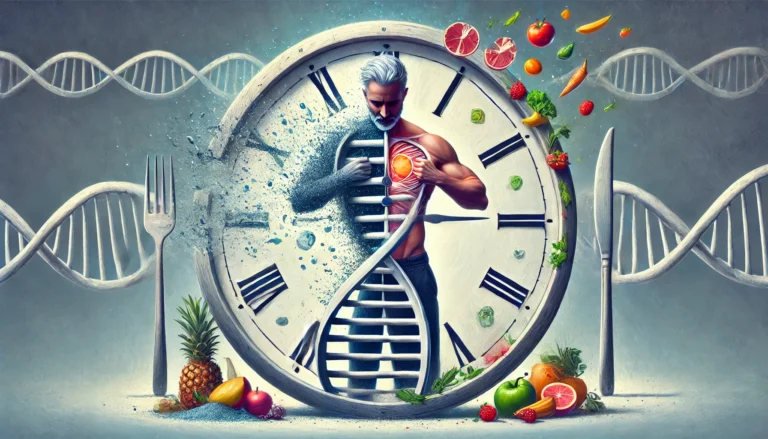If you’re in your 40s like me, you might’ve noticed that keeping those muscles toned isn’t quite as easy as it used to be. Trust me, I feel your pain! Did you know that after 40, we can lose up to 8% of our muscle mass per decade? Yikes! [1] That’s why I’ve become a bit obsessed with understanding our protein needs. So, grab a protein shake (or whatever you’re sipping on), and let’s dive into this meaty topic (pun totally intended).
Understanding Protein Requirements for Men in Their 40s
Alright, let’s get down to business. As we hit our 40s, our bodies start to play this annoying game called “let’s lose muscle mass for fun.” Not cool, body. Not cool at all. That’s where protein comes in – it’s like our secret weapon against this age-related muscle loss, also known as sarcopenia.
So, how much protein do we actually need? Well, it’s not as straightforward as you might think. The general recommendation is about 0.8 grams of protein per kilogram of body weight [2]. But here’s the kicker – that’s for sedentary adults. If you’re hitting the gym or chasing your kids around (which, let’s face it, is a workout in itself), you might need more.
Factors like your activity level, weight, and overall health play a role in determining your protein needs. For active guys in their 40s, some studies suggest we might benefit from up to 1.2 to 1.6 grams per kilogram of body weight [3]. That’s quite a jump!
Calculating Your Personal Protein Needs
Now, I know what you’re thinking – “Great, but how do I figure out MY protein needs?” Don’t worry, I’ve got you covered. Here’s a simple way to calculate it:
- Take your weight in pounds and divide it by 2.2 to get your weight in kilograms.
- Multiply that number by 0.8 for the minimum, and up to 1.6 if you’re very active.
For example, if you weigh 180 pounds (about 82 kg):
- Minimum: 82 x 0.8 = 66 grams of protein per day
- Maximum: 82 x 1.6 = 131 grams of protein per day
That’s quite a range, right? Start at the lower end and adjust based on your activity level and how you feel. Your body will let you know if it’s not enough!
Top Protein Sources for Men Over 40
Now that we know how much protein we need, let’s talk about where to get it. And no, it doesn’t all have to come from chicken breasts and protein shakes (though those are great options).
Animal-based protein sources:
- Lean meats (chicken, turkey, lean beef)
- Fish (salmon, tuna, tilapia)
- Eggs (the whole egg, folks – the yolk has nutrients too!)
- Dairy (Greek yogurt, cottage cheese, milk)
Plant-based protein sources:
- Legumes (beans, lentils, chickpeas)
- Nuts and seeds (almonds, chia seeds, pumpkin seeds)
- Whole grains (quinoa, oats, wild rice)
Here’s a fun fact: animal proteins are considered “complete” proteins because they contain all nine essential amino acids our bodies can’t produce [4]. Plant proteins are often “incomplete,” but don’t let that scare you off. By eating a variety of plant-based proteins throughout the day, you can still get all the amino acids you need.
To give you a better idea of how much protein you’re getting from different foods, here’s a handy reference table. Remember, these are approximate values, and actual protein content may vary slightly depending on the specific product or preparation method:
| Protein Source | Amount | Protein Content |
| Eggs | 2 large (100g / 3.5 oz) | 13g |
| Chicken Breast | 85g / 3 oz (cooked) | 26g |
| Salmon | 85g / 3 oz (cooked) | 22g |
| Greek Yogurt | 170g / 6 oz | 17g |
| Lentils | 198g / 7 oz (cooked, 1 cup) | 18g |
| Almonds | 28g / 1 oz (23 almonds) | 6g |
| Quinoa | 185g / 6.5 oz (cooked, 1 cup) | 8g |
| Tofu | 126g / 4.5 oz (1/2 cup) | 10g |
As you can see, animal sources like chicken breast and salmon pack a significant protein punch in a relatively small serving. But don’t overlook plant-based options like lentils and tofu – they not only provide a good amount of protein but also come with fiber and other beneficial nutrients.
Timing Your Protein Intake for Maximum Benefits
Okay, so we know what to eat, but when should we eat it? This is where it gets interesting. Instead of loading up on protein at dinner (guilty as charged), it’s better to spread it out throughout the day. Why? Because our bodies can only use so much protein at once for muscle building.
A study in the Journal of the American Dietetic Association suggested that consuming 25-30 grams of protein per meal may be optimal for muscle protein synthesis [5]. That’s about the amount in a 3-ounce piece of chicken breast or a cup of Greek yogurt with some nuts.
And for all you gym rats out there (or aspiring ones – it’s never too late to start!), having some protein before and after your workout can help with muscle recovery and growth. I’ve found that a small protein shake about 30 minutes before my workout and a proper meal within an hour after really helps with those post-workout aches.
Balancing Protein with Other Nutrients
Now, before you go all protein-crazy, remember that balance is key. We’re not spring chickens anymore, and our bodies need a well-rounded diet. Make sure you’re getting plenty of fruits, vegetables, and whole grains along with your protein.
Complex carbohydrates provide energy for your workouts and daily activities, while healthy fats are crucial for hormone production (including testosterone, which naturally declines as we age). Plus, many vitamins and minerals work hand-in-hand with protein to keep our bodies functioning optimally.
Protein Supplements: Are They Necessary?
Let’s talk about the elephant in the room – protein supplements. Walk into any gym, and you’ll see guys chugging protein shakes like there’s no tomorrow. But do we really need them?
The short answer is: maybe. If you’re struggling to meet your protein needs through food alone, a supplement can be a convenient option. Whey protein is a popular choice because it’s quickly absorbed, but there are also casein and plant-based options if dairy isn’t your thing.
Personally, I use a protein powder on days when I’m too busy for a proper meal or after a particularly grueling workout. But I try to get most of my protein from whole foods. They’re more satisfying and come with additional nutrients that supplements might lack.
Common Myths About Protein Intake for Men Over 40
Now, let’s bust some myths, shall we?
Myth 1: “High protein diets are bad for your kidneys.”
Truth: Unless you have existing kidney problems, research shows that high protein diets are generally safe for healthy individuals [6].
Myth 2: “More protein means more muscle, no matter what.”
Truth: While protein is crucial for muscle building, your body can only use so much. Excess protein can be stored as fat if you’re consuming more calories than you’re burning.
Myth 3: “Plant proteins are inferior to animal proteins.”
Truth: While animal proteins are “complete,” a varied plant-based diet can provide all the essential amino acids you need. Plus, plant proteins often come with fiber and other beneficial nutrients.
Incorporating Protein into Your Daily Meals
Alright, let’s get practical. How do we actually fit all this protein into our daily lives? Here are some ideas that have worked for me:
- Breakfast: Greek yogurt with berries and a handful of nuts, or a couple of eggs with whole-grain toast.
- Lunch: Grilled chicken salad with plenty of veggies, or a turkey and avocado sandwich on whole-grain bread.
- Dinner: Baked salmon with quinoa and roasted vegetables, or a lean beef stir-fry with brown rice.
- Snacks: Apple slices with peanut butter, or a small handful of almonds and a piece of cheese.
The key is to plan ahead. I’ve found that meal prepping on Sundays saves me from the dreaded “what’s for dinner” panic and keeps me from reaching for less healthy options.
Conclusion
There you have it, gents – the lowdown on protein needs for us 40-somethings. Remember, while protein is important, it’s just one piece of the puzzle. A balanced diet, regular exercise, and good sleep are all crucial for staying healthy and strong as we age.
Don’t be afraid to experiment and find what works best for you. Maybe you thrive on a plant-based diet, or perhaps you feel best with more animal proteins. Listen to your body, and don’t hesitate to consult with a healthcare provider or nutritionist if you have specific concerns.
So, are you ready to optimize your protein intake? Trust me, your 50-year-old self will thank you. Now, if you’ll excuse me, I’ve got a date with a grilled chicken salad. Stay strong, fellas!
Sources:
[1] Volpi E, et al. (2004). “Muscle tissue changes with aging”. Current Opinion in Clinical Nutrition and Metabolic Care.
[2] Institute of Medicine. (2005). “Dietary Reference Intakes for Energy, Carbohydrate, Fiber, Fat, Fatty Acids, Cholesterol, Protein, and Amino Acids”.
[3] Phillips SM, et al. (2016). “Protein “requirements” beyond the RDA: implications for optimizing health”. Applied Physiology, Nutrition, and Metabolism.
[4] Wu G. (2016). “Dietary protein intake and human health”. Food & Function.
[5] Paddon-Jones D, et al. (2009). “Protein, weight management, and satiety”. American Journal of Clinical Nutrition.
[6] Antonio J, et al. (2016). “The effects of consuming a high protein diet (4.4 g/kg/d) on body composition in resistance-trained individuals”. Journal of the International Society of Sports Nutrition.







